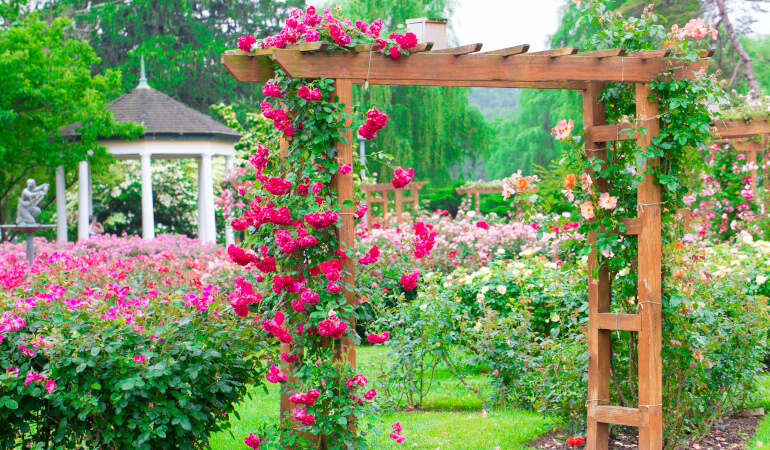
A garden arch elevates the aesthetic appeal of your garden and gives it sophistication. It looks, undoubtedly, good, but that’s not its only purpose. You can use it to hold climbing plants, frame a path, or split the garden into neat sections.
Truly a great invention of human ingenuity; however, to use it for all its benefits, you need to first assemble it. That’s no small feat, if you’ve never done it before, but it’s completely possible.
In this post you will learn how to make a garden arch from start to finish. You will see what tools and materials you need, the steps to build it, and simple tips to keep it strong for years.
Now go to the garden and…
Table of Contents
Find the right place for your garden arch
First decide on what you want an arch for. Do you want it as an entry to the garden, a main feature, a walkway cover, or a frame for climbing plants? The answer to this question will lead you to the right place.
Check sunlight and soil as well. Some plants need full sun, others cope better with shade. The soil under the arch needs to suit the plants you want to grow, so remember that.
In the UK, you also need to think about rain and wind. A strong gust can knock a weak arch over. For that reason, place it where you can fix it firmly in the ground. Pick a spot that drains well too, so the base does not sit in water all year long.
Decide on the material
A garden arch can be made from different materials. Each one determines how the arch looks, how long it lasts, and how much care it needs. Let’s discuss some common material options:
- Wood (cedar, redwood). It has a warm look and natural feel, however, it can rot if not treated. It may not last as long as other options.
- Metal (wrought iron, aluminium). It’s strong and long-lasting. Great if you want a modern or classic look, however, it may rust if not coated.
- PVC or composite. Light, easy to put up, and needs almost no care. It may not give the same charm as wood or metal but it is handy for DIY work.
You may now wonder, what is the best material for a garden arch? The best pick is the one that fits your garden, your budget, and your local weather. And what does that look like for the UK?
In the UK, pressure-treated timber blends well with traditional cottage-style gardens and doesn’t rot. Rust-proof metal, on the other hand, copes with rain and damp air. That makes it perfect for modern or formal gardens. PVC works if you want something light and low-care. It’s good for a small backyard and doesn’t require much time for upkeep.
When you have to choose a material, think about:
- Climate. In rainy or windy spots, rust-resistant steel or pressure-treated timber holds up well. In damp, shady corners, timber that resists rot is the safest choice. If your garden is drier, even simple softwood can serve you for a fair while.
- Budget. The price matters, but so does value. Softwood timber is the cheapest and easy to replace, but it will not last as long. Cedar costs more and gives a warm, natural look with decent durability. If you are ready to invest more, wrought iron offers strength and elegance that, with care, can last for decades.
How to build a simple wooden garden arch in your backyard
You are completely capable of making a wooden garden arch that looks great and stands strong.
You will need the following tools and materials:
- Saw
- Drill
- Screws
- Hammer
- Tape measure
- Spirit level
- Safety gloves and goggles
- Wooden posts and beams
- Concrete or metal spikes (for fixing the arch into the ground)
- Optional extras: Wood glue (extra strength for joints); Trellis panels (for climbing plants or added detail); Wood stain or paint (to protect against rain and give colour)
When you have all that, you are ready to make a wooden garden arch.
Step 1: Measure and plan the layout
Measure the space where you want the arch. Think about how tall and wide you want the garden archway to be. Sketch a simple design before you cut any wood. This, hopefully will help you avoid mistakes later.
Step 2: Build the frame
Cut two tall posts for the sides of the arch. These will stand upright and form the vertical supports. Next, cut two shorter pieces for the top. These will connect the posts.
If you want a flat-topped arch, leave the cross beams straight. If you want a curved top, draw the curve directly on the top surface of the cross beams. Afterwards, cut along the line with a jigsaw. For a softer, rounded arch, use thin strips of wood. You should bend them into shape across the posts, and fix them in place.
Lay the posts and cross beams on the ground in the shape of the arch. Attach each joint with screws. Once the frame is secure, stand it upright and place a spirit level across the top beam. Make sure it sits level and the frame is square.
Step 3: Secure the arch to the ground
You have two ways to secure the arch.
Option 1: Concrete footing
The best choice when you need maximum stability and long-term strength.
- Dig a hole for each post about 30–40 cm deep. Make the hole slightly wider than the post so that the concrete can surround it fully.
- Place the post upright in the hole. Position it roughly where it will stay.
- Mix the concrete according to the bag instructions until it has a thick, pourable consistency.
- Pour the concrete carefully around the base of the post. Tap the post lightly or poke it with a stick to remove air pockets so the concrete settles evenly.
- Place a spirit level on the post to check that it stands perfectly vertical. Adjust the post until it is straight before the concrete sets.
- Leave the concrete for at least 24 hours to harden. Do not touch or put any weight on the post during this time. Once the concrete has set, the post is firmly anchored and ready for the top beams.
Option 2: Metal spikes
Metal spikes (or post anchors) are usually best when you want a quick, low-dig installation or when you don’t want to use concrete.
- Choose the exact spot for each post.
- Drive a metal spike or post anchor into the ground about 30–40 cm deep. Make sure the spike sits firm.
- Place the bottom of each post into the bracket or flat top of the spike so it fits snugly.
- Use a spirit level on each post to check that it stands perfectly vertical. Adjust the post until it is straight.
- Press soil firmly around the spike. Add extra soil or small stones if the ground is soft.
- Check the arch for stability. Make sure it does not wobble before attaching the top beams.
Step 4: Finishing touches
Add trellis panels to the sides of the wooden arch to support climbing plants. Sand all edges to remove rough spots and apply a weatherproof stain or paint to protect the wood and enhance its appearance. These steps make the arch safe, attractive, and ready for plants.
Metal arches offer strength and longevity, but they often need welding or specialist tools to join the pieces securely. If you want a metal arch, but lack the right skills or equipment, you are better of hiring a professional landscaper.
PVC or composite arches are light and low-maintenance. Some designs come with pieces that fit together easily.
What to plant around your arch?
The right plants can add colour, scent, and charm to your garden arch. Climbing plants suit garden arches best. Since you are in the UK, you could try planting:
- Roses – A classic choice. They provide colour and a strong fragrance. Choose varieties suited to your local climate. Some bloom in summer only, others repeat. Plant them at the base and tie new shoots to the arch gently.
- Honeysuckle – Sweet-smelling flowers that attract bees and butterflies. It grows quickly, so you may need to prune excess growth to keep the arch tidy.
- Jasmine – Offers delicate flowers and a lovely scent. Evergreen varieties keep their leaves all year. Train stems along the frame carefully to cover gaps.
- Clematis – Available in many colours and flowering times. Some bloom in spring, others in summer or autumn. Attach each stem to the arch via soft ties or twine.
How to look after your garden arch
Once you build your garden arch, you have to take the time to take care of it so it can last.
Check the arch for damage
Look for loose joints, leaning posts, especially after storms or strong winds. Loose joints can make the structure unstable. On the other hand, leaning posts can put stress on climbing plants or even cause the arch to fall. If you spot a problem, tighten screws or bolts, add wood glue to wooden joints, or re-set leaning posts deeper into the ground. Use concrete or metal spikes for extra stability.
Trim climbing plants often
Heavy or overgrown stems can bend or break the frame. Dead or weak stems can attract pests or disease. You need to cut back excess growth to guide healthy stems along the frame so the weight spreads evenly. This protects both the plants and the structure.
Protect wooden arches from rot
Untreated wood absorbs water, swells, and can decay quickly. Apply a weatherproof stain or paint to cope with UK rain and damp air. Inspect the wood each year and touch up areas that show wear. If you find rot, sand away soft wood, fill small cracks with wood filler, or replace severely damaged beams.
For metal arches, check for rust regularly. Rust weakens the structure and can eventually cause failure. Sand off any rusty spots and apply a rust-proof paint or coating. Replace corroded screws or bolts.
Do you want to change the look of your garden? Book a landscaping service with a professional.
Enter your postcode to view our rates and availability in your area.
For questions about the services we offer visit our main site
Takeaways
- Decide what you want the arch for. It might be for an entry path or plant support.
- Choose the material carefully acourding to the weather in your city.
- You can create a wooden arch yourself. A metal one, on the other hand, requires a professional’s touch.
- Maintain regularly by trimming plants and fixing damage.



